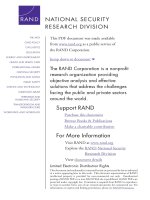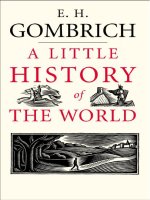A history of the world in 6 glasses
Bạn đang xem bản rút gọn của tài liệu. Xem và tải ngay bản đầy đủ của tài liệu tại đây (2.36 MB, 213 trang )
Tai Lieu Chat Luong
"Historians, understandably, devote most of their attention to war, politics and,
not least, money. But history can also be seen through the prism of the
commodities that money buys. In A History of the World in Six Glasses, Tom
Standage argues that beer, wine, spirits, coffee, tea and cola have each, in their
own way, helped to shape the course of history."—Matthew Rees, Wall Street
Journal
"When Standage decided to follow his readable study of an 18th-century chessplaying automaton, The Turk, with a book about six beverages that really did
change the world, he had the grace to take both the title and the story in a new
direction."—Stephen Meuse, Boston Globe
"Memorable facts . . . abound in Tom Standage's delightful A History of the
World in Six Glasses."—Jeffrey Tannenbaum, Bloomberg.com
"A clever, tight retelling of human history as it refracts through six beverages:
beer, wine, spirits, tea, coffee and Coca-Cola . . . Raise a glass to Standage for
writing this one. His work allows us to ponder the history contained in the drinks
we bring to our lips."—Cleveland Plain Dealer
"The book makes an easy and agreeable read, never seeming discursive or
unwieldy, despite the vast amount of ground it covers. I'll happily raise my glass
to that."—Yiling Chen-Josephson, Newsday
"A romp, offering a systematic chronology of human affairs from a specific
viewpoint... An engaging thesis . . . This thesis happens to view instructively the
panorama of history through drink; I say skoal!"—Philip Kopper, Washington
Times
"Standage starts with a bold hypothesis—that each epoch, from the Stone Age
to the present, has had its signature beverage—and takes readers on an
extraordinary trip through world history. The Economist's technology editor has
the ability to connect the smallest detail to the big picture and a knack for
summarizing vast concepts in a few sentences."—Publishers Weekly (starred
review)
"History, along with a bit of technology, etymology, chemistry and bibulous
entertainment. Bottoms up!"—Kirkus Reviews
ALSO BY TOM STANDAGE
The Neptune File
The Turk
The Victorian Internet
A HISTORY of the WORLD
in 6 GLASSES
TOM STANDAGE
Copyright © 2005 by Tom Standage
All rights reserved. No part of this book may be used or reproduced in any manner whatsoever
without written permission from the publisher except in the case of brief quotations embodied in
critical articles or reviews. For information address Walker & Company, 104 Fifth Avenue, New
York. New York 10011.
Published in 2006 by Walker Publishing Company Inc.
Distributed to the trade by Holtzbrinck Publishers
All papers used by Walker & Company are natural, recyclable products made from wood grown in
well-managed forests. The manufacturing processes conform to the environmental regulations of the
country of origin.
Art credits: the University of Pennsylvania Museum; the original object is in the Iraq Museum (IM
# 25048). Created by the author. © the Trustees of The British Museum. (Engraving based on bust
in the Uffizi Gallery, Florence), (engraving after Sir Peter Lely), (engraving by W. Holl after a picture
by Gilbert Stewart), the Mary Evans Picture Library. North Wind Picture Archives. Courtesy of
The Coca-Cola Company. Vice President Nixon in Russia and Poland 1959 (photos); Series 1959
U.S.S.R. Trip Photographs; Pre-Presidential Papers of Richard M. Nixon; courtesy of the National
Archives—Pacific Region (Taguna Niguel).
The Library of Congress has cataloged the hardcover edition of this book under LCCN:
2004061209
eISBN: 978-0-802-71859-4
First published in the United States in 2005 by Walker & Company This paperback edition
published in 2006
Visit Walker & Company's Web site at www.walkerbooks.com
Book design by Chris Welch
Typeset by Coghill Composition Company
Printed in the United States of America by Quebecor World Fairfield
8 10 9 7
To my parents
Contents
Introduction. Vital Fluids
Beer in Mesopotamia and Egypt
1. A Stone-Age Brew
2. Civilized Beer
Wine in Greece and Rome
3. The Delight of Wine
4. The Imperial Vine
Spirits in the Colonial Period
5. High Spirits, High Seas
6. The Drinks That Built America
Coffee in the Age of Reason
7. The Great Soberer
8. The Coffeehouse Internet
Tea and the British Empire
9. Empires of Tea
10. Tea Power
Coca-Cola and the Rise of America
11. From Soda to Cola
12. Globalization in a Bottle
Epilogue. Back to the Source
Acknowledgments
Appendix. In Search of Ancient Drinks
Notes
Sources
Introduction
Vital Fluids
There is no history of mankind, there are only many
histories of all kinds of aspects of human life.
—Karl Popper, philosopher of science (1902-94)
THIRST is DEADLIER than hunger. Deprived of food, you might survive for a
few weeks, but deprived of liquid refreshment, you would be lucky to last more
than a few days. Only breathing matters more. Tens of thousands of years ago,
early humans foraging in small bands had to remain near rivers, springs, and
lakes to ensure an adequate supply of freshwater, since storing or carrying it was
impractical. The availability of water constrained and guided humankind's
progress. Drinks have continued to shape human history ever since.
Only in the past ten thousand years or so have other beverages emerged to
challenge the preeminence of water. These drinks do not occur naturally in any
quantity but must be made deliberately. As well as offering safer alternatives to
con taminated, disease-ridden water supplies in human settlements, these new
beverages have taken on a variety of roles. Many of them have been used as
currencies, in religious rites, as political symbols, or as sources of philosophical
and artistic inspiration. Some have served to highlight the power and status of the
elite, and others to subjugate or appease the downtrodden. Drinks have been
used to celebrate births, commemorate deaths, and forge and strengthen social
bonds; to seal business transactions and treaties; to sharpen the senses or dull
the mind; to convey lifesaving medicines and deadly poisons.
As the tides of history have ebbed and flowed, different drinks have come to
prominence in different times, places, and cultures, from stone-age villages to
ancient Greek dining rooms or Enlightenment coffeehouses. Each one became
popular when it met a particular need or aligned with a historical trend; in some
cases, it then went on to influence the course of history in unexpected ways. Just
as archaeologists divide history into different periods based on the use of
different materials—the stone age, the bronze age, the iron age, and so on—it is
also possible to divide world history into periods dominated by different drinks.
Six beverages in particular—beer, wine, spirits, coffee, tea, and cola—chart the
flow of world history. Three contain alcohol, and three contain caffeine, but what
they all have in common is that each one was the defining drink during a pivotal
historical period, from antiquity to the present day.
The event that set humankind on the path toward modernity was the adoption
of farming, beginning with the domestication of cereal grains, which first took
place in the Near East around ten thousand years ago and was accompanied by
the appearance of a rudimentary form of beer. The first civilizations arose around
five thousand years later in Mesopotamia and Egypt, two parallel cultures
founded on a surplus of cereal grains produced by organized agriculture on a
massive scale. This freed a small fraction of the population from the need to
work in the fields and made possible the emergence of specialist priests,
administrators, scribes, and craftsmen. Not only did beer nourish the inhabitants
of the first cities and the authors of the first written documents, but their wages
and rations were paid in bread and beer, as cereal grains were the basis of the
economy.
The flourishing culture that developed within the city-states of ancient Greece
in the first millennium BCE spawned advances in philosophy, politics, science,
and literature that still underpin modern Western thought. Wine was the lifeblood
of this Mediterranean civilization, and the basis of vast seaborne trade that
helped to spread Greek ideas far and wide. Politics, poetry, and philosophy
were discussed at formal drinking parties, or symposia, in which the participants
drank from a shared bowl of diluted wine. The spread of wine drinking
continued under the Romans, the structure of whose hierarchical society was
reflected in a minutely calibrated pecking order of wines and wine styles. Two of
the world's major religions issued opposing verdicts on the drink: The Christian
ritual of the Eucharist has wine at its center, but following the collapse of the
Roman Empire and the rise of Islam, wine was banned in the very region of its
birth.
The rebirth of Western thought a millennium after the fall of Rome was
sparked by the rediscovery of Greek and Roman knowledge, much of which
had been safeguarded and extended by scholars in the Arab world. At the same
time, European explorers, driven by the desire to circumvent the Arab monopoly
on trade with the East, sailed west to the Americas and east to India and China.
Global sea routes were established, and European nations vied with one another
to carve up the globe. During this Age of Exploration a new range of beverages
came to the fore, made possible by distillation, an alchemical process known in
the ancient world but much improved by Arab scholars. Distilled drinks provided
alcohol in a compact, durable form ideal for sea transport. Such drinks as
brandy, rum, and whiskey were used as currency to buy slaves and became
particularly popular in the North American colonies, where they became so
politically contentious that they played a key role in the establishment of the
United States.
Hard on the heels of this geographic expansion came its intellectual
counterpart, as Western thinkers looked beyond long-held beliefs inherited from
the Greeks and devised new scientific, political, and economic theories. The
dominant drink of this Age of Reason was coffee, a mysterious and fashionable
beverage introduced to Europe from the Middle East. The establishments that
sprung up to serve coffee had a markedly different character from taverns that
sold alcoholic drinks, and became centers of commercial, political, and
intellectual exchange. Coffee promoted clarity of thought, making it the ideal
drink for scientists, businessmen, and philosophers. Coffeehouse discussions led
to the establishment of scientific societies, the founding of newspapers, the
establishment of financial institutions, and provided fertile ground for
revolutionary thought, particularly in France.
In some European nations, and particularly in Britain, coffee was challenged
by tea imported from China. Its popularity in Europe helped to open lucrative
trade routes with the East and underpinned imperialism and industrialization on
an unprecedented scale, enabling Britain to become the first global superpower.
Once tea had established itself as Britain's national drink, the desire to maintain
the tea supply had far-reaching effects on British foreign policy, contributing to
the independence of the United States, the undermining of China's ancient
civilization, and the establishment of tea production in India on an industrial scale.
Although artificially carbonated beverages originated in Europe in the late
eighteenth century, the soft drink came into its own with the invention of CocaCola one hundred years later. Originally devised as a medicinal pick-me-up by
an Atlanta pharmacist, it became America's national drink, an emblem of the
vibrant consumer capitalism that helped to transform the United States into a
superpower. Traveling alongside American servicemen as they fought wars
around the world during the twentieth century, Coca-Cola went on to become
the world's most widely known and distributed product and is now an icon of the
controversial march toward a single global marketplace.
Drinks have had a closer connection to the flow of history than is generally
acknowledged, and a greater influence on its course. Understanding the
ramifications of who drank what, and why, and where they got it from, requires
the traversal of many disparate and otherwise unrelated fields: the histories of
agricul ture, philosophy, religion, medicine, technology, and commerce. The six
beverages highlighted in this book demonstrate the complex interplay of different
civilizations and the interconnectedness of world cultures. They survive in our
homes today as living reminders of bygone eras, fluid testaments to the forces
that shaped the modern world. Uncover their origins, and you may never look at
your favorite drink in quite the same way again.
BEER in
MESOPOTAMIA
and EGYPT
1
A Stone-Age Brew
Fermentation and civilization are inseparable.
—John Ciardi, American poet (1916-86)
A Pint of Prehistory
THE HUMANS WHO migrated out of Africa starting around 50,000 years
ago traveled in small nomadic bands, perhaps thirty strong, and lived in caves,
huts, or skin tents. They hunted game, caught fish and shellfish, and gathered
edible plants, moving from one temporary camp to another to exploit seasonal
food supplies. Their tools included bows and arrows, fishhooks, and needles.
But then, starting around 12,000 years ago, a remarkable shift occurred.
Humans in the Near East abandoned the old hunter-gatherer lifestyle of the
Paleolithic period (old stone age) and began to take up farming instead, settling
down in villages which eventually grew to become the world's first cities. They
also developed many new technologies, including pottery, wheeled vehicles, and
writing.
Ever since the emergence of "anatomically modern" humans, or Homo sapiens
sapiens, in Africa around 150,000 years ago, water had been humankind's basic
drink. A fluid of primordial importance, it makes up two-thirds of the human
body, and no life on Earth can exist without it. But with the switch from the
hunter-gatherer lifestyle to a more settled way of life, humans came to rely on a
new beverage derived from barley and wheat, the cereal grains that were the first
plants to be deliberately cultivated. This drink became central to social, religious,
and economic life and was the staple beverage of the earliest civilizations. It was
the drink that first helped humanity along the path to the modern world: beer.
Exactly when the first beer was brewed is not known. There was almost
certainly no beer before 10,000 BCE, but it was widespread in the Near East by
4000 BCE, when it appears in a pictogram from Mesopotamia, a region that
corresponds to modern-day Iraq, depicting two figures drinking beer through
reed straws from a large pottery jar. (Ancient beer had grains, chaff, and other
debris floating on its surface, so a straw was necessary to avoid swallowing
them.)
Since the first examples of writing date from around 3400 BCE, the earliest
written documents can shed no direct light on beer's origins. What is clear,
however, is that the rise of beer was closely associated with the domestication of
the cereal grains from which it is made and the adoption of farming. It came into
existence during a turbulent period in human history that witnessed the switch
from a nomadic to a settled lifestyle, followed by a sudden increase in social
complexity manifested most strikingly in the emergence of cities. Beer is a liquid
relic from human prehistory, and its origins are closely intertwined with the
origins of civilization itself.
A pictogram from a seal found at Tepe Gawra in Mesopotamia dating from
around 4000 BCE. It shows two figures drinking beer through straws from a
large pottery jar.
The Discovery of Beer
Beer was not invented but discovered. Its discovery was inevitable once the
gathering of wild grains became widespread after the end of the last ice age,
around 10,000 BCE, in a region known as the Fertile Crescent. This area
stretches from modern-day Egypt, up the Mediterranean coast to the southeast
corner of Turkey, and then down again to the border between Iraq and Iran. It is
so named because of a happy accident of geography.
When the ice age ended, the uplands of the region provided an ideal
environment for wild sheep, goats, cattle, and pigs—and, in some areas, for
dense stands of wild wheat and barley. This meant the Fertile Crescent provided
unusually rich pickings for roving bands of human hunter-gatherers. They not
only hunted animals and gathered edible plants but collected the abundant cereal
grains growing wild in the region.
The Fertile Crescent, a region of the Near East where humans first took up
farming and established large-scale settlements (shown here as black dots)
Such grains provided an unexciting but reliable source of food. Although
unsuitable for consumption when raw, they can be made edible by roughly
pounding or crushing them and then soaking them in water. Initially, they were
probably just mixed into soup. A variety of ingredients such as fish, nuts, and
berries would have been mixed with water in a plastered or bitumen-lined
basket. Stones, heated in a fire, were then dropped in, using a forked stick.
Grains contain tiny granules of starch, and when placed in hot water they absorb
moisture and then burst, releasing the starch into the soup and thickening it
considerably.
Cereal grains, it was soon discovered, had another unusual property: Unlike
other foodstuffs, they could be stored for consumption months or even years
later, if kept dry and safe. When no other foodstuffs were available to make
soup, they could be used on their own to make either a thick porridge or a thin
broth or gruel. This discovery led to the development of tools and techniques to
collect, process, and store grain. It involved quite a lot of effort but provided a
way to guard against the possibility of future food shortages. Throughout the
Fertile Crescent there is archaeological evidence from around 10,000 BCE of
flint-bladed sickles for harvesting cereal grains, woven baskets for carrying them,
stone hearths for drying them, underground pits for storing them, and grindstones
for processing them.
Although hunter-gatherers had previously led semisettled rather than entirely
nomadic lives, moving between a number of temporary or seasonal shelters, the
ability to store cereal grains began to encourage people to stay in one place. An
experiment carried out in the 1960s shows why. An archaeologist used a flintbladed sickle to see how efficiently a prehistoric family could have harvested
wild grains, which still grow in some parts of Turkey. In one hour he gathered
more than two pounds of grain, which suggested that a family that worked eighthour days for three weeks would have been able to gather enough to provide
each family member with a pound of grain a day for a year. But this would have
meant staying near the stands of wild cereals to ensure the family did not miss the
most suitable time to harvest them. And having gathered a large quantity of grain,
they would be reluctant to leave it unguarded.
The result was the first permanent settlements, such as those established on the
eastern coast of the Mediterranean from around 10,000 BCE. They consisted of
simple, round huts with roofs supported by wooden posts and floors sunk up to
a yard into the ground. These huts usually had a hearth and a floor paved with
stones and were four or five yards in diameter. A typical village consisted of
around fifty huts, supporting a community of two hundred or three hundred
people. Although the residents of such villages continued to hunt wild animals
such as gazelles, deer, and boar, skeletal evidence suggests that they subsisted
on a mainly plant-based diet of acorns, lentils, chickpeas, and cereals, which at
this stage were still gathered in the wild, rather than cultivated deliberately.
Cereal grains, which started off as relatively unimportant foodstuffs, took on
greater significance following the discovery that they had two more unusual
properties. The first was that grain soaked in water, so that it starts to sprout,
tastes sweet. It was difficult to make storage pits perfectly watertight, so this
property would have become apparent as soon as humans first began to store
grain. The cause of this sweetness is now understood: Moistened grain produces
diastase enzymes, which convert starch within the grain into maltose sugar, or
malt. (This process occurs in all cereal grains, but barley produces by far the
most diastase enzymes and hence the most maltose sugar.) At a time when few
other sources of sugar were available, the sweetness of this "malted" grain would
have been highly valued, prompting the development of deliberate malting
techniques, in which the grain was first soaked and then dried.
The second discovery was even more momentous. Gruel that was left sitting
around for a couple of days underwent a mysterious transformation, particularly
if it had been made with malted grain: It became slightly fizzy and pleasantly
intoxicating, as the action of wild yeasts from the air fermented the sugar in the
gruel into alcohol. The gruel, in short, turned into beer. Even so, beer was not
necessarily the first form of alcohol to pass human lips. At the time of beer's
discovery, alcohol from the accidental fermentation of fruit juice (to make wine)
or water and honey (to make mead) would have occurred naturally in small
quantities as people tried to store fruit or honey. But fruit is seasonal and
perishes easily, wild honey was only available in limited quantities, and neither
wine nor mead could be stored for very long without pottery, which did not
emerge until around 6000 BCE. Beer, on the other hand, could be made from
cereal crops, which were abundant and could be easily stored, allowing beer to
be made reliably, and in quantity, when needed. Long before pottery was
available, it could have been brewed in pitch-lined baskets, leather bags or
animal stomachs, hollowed-out trees, large shells, or stone vessels. Shells were
used for cooking as recently as the nineteenth century in the Amazon basin, and
Sahti, a traditional beer made in Finland, is still brewed in hollowed-out trees
today.
Once the crucial discovery of beer had been made, its quality was improved
through trial and error. The more malted grain there is in the original gruel, for
example, and the longer it is left to ferment, the stronger the beer. More malt
means more sugar, and a longer fermentation means more of the sugar is turned
into alcohol. Thoroughly cooking the gruel also contributes to the beer's strength.
The malting process converts only around 15 percent of the starch found in
barley grains into sugar, but when malted barley is mixed with water and brought
to the boil, other starch-converting enzymes, which become active at higher
temperatures, turn more of the starch into sugar, so there is more sugar for the
yeast to transform into alcohol.
Ancient brewers also noticed that using the same container repeatedly for
brewing produced more reliable results. Later historical records from Egypt and
Mesopotamia show that brewers always carried their own "mash tubs" around
with them, and one Mesopotamian myth refers to "containers which make the
beer good." Repeated use of the same mash tub promoted successful
fermentation because yeast cultures took up residence in the container's cracks
and crevices, so that there was no need to rely on the more capricious wild
yeast. Finally, adding berries, honey, spices, herbs, and other flavorings to the
gruel altered the taste of the resulting beer in various ways. Over the next few
thousand years, people discovered how to make a variety of beers of different
strengths and flavors for different occasions.
Later Egyptian records mention at least seventeen kinds of beer, some of them
referred to in poetic terms that sound, to modern ears, almost like advertising
slogans: Different beers were known as "the beautiful and good," "the heavenly,"
"the joy-bringer," "the addition to the meal," "the plentiful," "the fermented."
Beers used in religious ceremonies also had special names. Similarly, early
written references to beer from Mesopotamia, in the third millennium BCE, list
over twenty different kinds, including fresh beer, dark beer, fresh-dark beer,
strong beer, red-brown beer, light beer, and pressed beer. Red-brown beer was
a dark beer made using extra malt, while pressed beer was a weaker, more
watery brew that contained less grain. Mesopotamian brewers could also control
the taste and color of their beer by adding different amounts of bappir, or beerbread. To make bappir, sprouted barley was shaped into lumps, like small
loaves, which were baked twice to produce a dark-brown, crunchy, unleavened
bread that could be stored for years before being crumbled into the brewer's vat.
Records indicate that bappir was kept in government storehouses and was only
eaten during food shortages; it was not so much a foodstuff as a convenient way
to store the raw material for making beer..
The Mesopotamian use of bread in brewing has led to much debate among
archaeologists, some of whom have suggested that bread must therefore be an
offshoot of beer making, while others have argued that bread came first and was
subsequently used as an ingredient in beer. It seems most likely, however, that
both bread and beer were derived from gruel. A thick gruel could be baked in
the sun or on a hot stone to make flatbread; a thin gruel could be left to ferment
into beer. The two were different sides of the same coin: Bread was solid beer,
and beer was liquid bread.
Under the Influence of Beer?
Since writing had not been invented at the time, there are no written records to
attest to the social and ritual importance of beer in the Fertile Crescent during the
new stone age, or Neolithic period, between 9000 BCE and 4000 BCE. But
much can be inferred from later records of the way beer was used by the first
literate civilizations, the Sumerians of Mesojpotamia and the ancient Egyptians.
Indeed, so enduring are the cultural traditions associated with beer that some of
them survive to this day.
From the start, it seems that beer had an important function as a social drink.
Sumerian depictions of beer from the third millennium BCE generally show two
people drinking through straws from a shared vessel. By the Sumerian period,
however, it was possible to filter the grains, chaff, and other debris from beer,
and the advent of pottery meant it could just as easily have been served in
individual cups. That beer drinkers are, nonetheless, so widely depicted using
straws suggests that it was a ritual that persisted even when straws were no
longer necessary.
The most likely explanation for this preference is that, unlike food, beverages
can genuinely be shared. When several people drink beer from the same vessel,
they are all consuming the same liquid; when cutting up a piece of meat, in
contrast, some parts are usually deemed to be more desirable than others. As a
result, sharing a drink with someone is a universal symbol of hospitality and
friendship. It signals that the person offering the drink can be trusted, by
demonstrating that it is not poisoned or otherwise unsuitable for consumption.
The earliest beer, brewed in a primitive vessel in an era that predated the use of
individual cups, would have to have been shared. Although it is no longer
customary to offer visitors a straw through which to drink from a communal vat
of beer, today tea or coffee may be offered from a shared pot, or a glass of wine
or spirits from a shared bottle. And when drinking alcohol in a social setting, the
clinking of glasses symbolically reunites the glasses into a single vessel of shared
liquid. These are traditions with very ancient origins.
Just as ancient is the notion that drinks, and alcoholic drinks in particular, have
supernatural properties. To Neolithic drinkers, beer's ability to intoxicate and
induce a state of altered consciousness seemed magical. So, too, did the
mysterious process of fermentation, which transformed ordinary gruel into beer.
The obvious conclusion was that beer was a gift from the gods; accordingly,
many cultures have myths that explain how the gods invented beer and then
showed humankind how to make it. The Egyptians, for example, believed that
beer was accidentally discovered by Osiris, the god of agriculture and king of the
afterlife. One day he prepared a mixture of water and sprouted grain, but forgot
about it and left it in the sun. He later returned to find the gruel had fermented,
decided to drink it, and was so pleased with the result that he passed his
knowledge on to humankind. (This tale seems to tally closely with the way beer
was probably discovered in the stone age.) Other beer-drinking cultures tell
similar stories.
Since beer was a gift from the gods, it was also the logical thing to present as a
religious offering. Beer was certainly used in religious ceremonies, agricultural
fertility rites, and funerals by the Sumerians and the Egyptians, so it seems likely
that its religious use goes back farther still. Indeed, the religious significance of
beer seems to be common to every beer-drinking culture, whether in the
Americas, Africa, or Eurasia. The Incas offered their beer, called chicha, to the
rising sun in a golden cup, and poured it on the ground or spat out their first
mouthful as an offering to the gods of the Earth; the Aztecs offered their beer,
called pulque, to Mayahuel, the goddess of fertility. In China, beers made from
millet and rice were used in funerals and other ceremonies. The practice of
raising a glass to wish someone good health, a happy marriage, or a safe passage
into the afterlife, or to celebrate the successful completion of a project, is the
modern echo of the ancient idea that alcohol has the power to invoke
supernatural forces.
Beer and Farming, the Seeds of Modernity
Some anthropologists have even suggested that beer might have played a central
role in the adoption of agriculture, one of the turning points of human history.
Farming paved the way for the emergence of civilization by creating food
surpluses, freeing some members of society from the need to produce food and
enabling them to specialize in particular activities and crafts, and so setting
humanity on the path to the modern world. This happened first in the Fertile
Crescent, starting around 9000 BCE, as people began cultivating barley and
wheat deliberately, rather than simply gathering wild grains for consumption and
storage.
Of course, the switch from hunting and gathering to farming was a gradual
transition over a few thousand years, as deliberately cultivated crops played an
increasingly significant dietary role. Yet in the grand scheme of human history, it
happened in an eyeblink. Humans had been hunter-gatherers ever since
humankind diverged from the apes, around seven million years earlier; then they
suddenly took up farming. Exactly why the switch to farming occurred, and
occurred when it did, is still hotly debated, and there are dozens of theories.
Perhaps the amount of food available to hunter-gatherers in the Fertile Crescent
diminished, for example, either because of climatic changes, or because some
species died out or were hunted to extinction. Another possibility is that a more
sedentary (but still hunter-gatherer) lifestyle increased human fertility, allowing the
population to grow and creating demand for new sources of food. Or perhaps
once beer had been discovered, and its consumption had become socially and
ritually important, there was a greater desire to ensure the availability of grain by
deliberate farming, rather than relying on wild grains. Farming was, according to
this view, adopted partly in order to maintain the supply of beer.
Tempting though it is to attribute the adoption of agriculture entirely to beer, it
seems most likely that beer drinking was just one of many factors that helped to
tip the balance away from hunting and gathering and toward farming and a
sedentary lifestyle based on small settlements. Once this transition had begun, a
ratchet effect took hold: The more farming was relied on as a means of food
production by a particular community, and the more its population grew, the
harder it was to go back to the old nomadic lifestyle based on hunting and
gathering.
Beer drinking would also have assisted the transition to farming in a more
subtle way. Because long-term storage of beer was difficult, and complete
fermentation takes up to a week, most beer would have been drunk much
sooner, while still fermenting. Such a beer would have had a relatively low
alcohol content by modern standards but would have been rich in suspended
yeast, which dramatically improved its protein and vitamin content. The high level
of vitamin B, in particular, would have compensated for the decline in the
consumption of meat, the usual source of that vitamin, as hunting gave way to
farming.
Furthermore, since it was made using boiled water, beer was safer to drink
than water, which quickly becomes contaminated with human waste in even the
smallest settlements. Although the link between contaminated water and ill health
was not understood until modern times, humans quickly learned to be wary of
unfamiliar water supplies, and to drink where possible from clear-running
streams away from human settlements. (Hunter-gatherers did not have to worry
about contaminated water supplies, since they lived in small, mobile bands and
left their human waste behind when they moved on.) In other words, beer helped
to make up for the decline in food quality as people took up farming, provided a
safe form of liquid nourishment, and gave groups of beer-drinking farmers a
comparative nutritional advantage over non-beer drinkers.
Farming spread throughout the Fertile Crescent between 7000 BCE and 5000
BCE, as an increasing number of plants and animals (starting with sheep and
goats) were domesticated, and new irrigation techniques made farming possible
on the hot, dry lowlands of Mesopotamia and in the Nile Valley of Egypt. A
typical farming village of the period consisted of huts built from clay and reed
mats, and perhaps some rather grander houses built of sun-dried mud bricks.
Beyond the village would have been fields where cereals, dates, and other crops
were cultivated, with a few sheep and oxen tethered or penned nearby. Wild
fowl, fish, and game, when available, supplemented the villagers' diet. It was a
very different lifestyle from the hunting and gathering of just a few thousand years
earlier. And the transition toward an even more complex society had begun.
Settlements from this period often had a storehouse where valuable items were
kept, including sacred objects and stores of surplus food. These storehouses
were definitely communal, since they were far larger than would have been
needed by any single family.
Keeping surplus food in the storehouse was one way to ward off future food
shortages; ritual and religious activity, in which the gods were called upon to
ensure a good harvest, was another. As these two activities became intertwined,
deposits of surplus food came to be seen as offerings to the gods, and the
storehouses became temples. To ensure all villagers were pulling their weight,
contributions to the common storehouse were recorded using small clay tokens,
found throughout the Fertile Crescent from as early as 8000 BCE. Such
contributions were justified as religious offerings by administrator-priests who
lived off the surplus food and directed communal activities, such as the
construction of buildings and the maintenance of irrigation systems. Thus were
sown the seeds of accountancy, writing, and bureaucracy.
The idea that beer provided some of the impetus for this dramatic shift in the
nature of human activity, after millions of years of hunting and gathering, remains
controversial. But the best evidence for the importance of beer in prehistoric
times is its extraordinary significance to the people of the first great civilizations.
For although the origins of this ancient drink inevitably remain shrouded in
mystery and conjecture, there is no question that the daily lives of Egyptians and
Mesopotamians, young and old, rich and poor, were steeped in beer.









